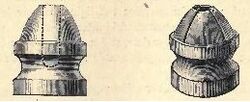The Holland & Holland Paradox Gun, manufactured by the British firm Holland & Holland, is an unusual shotgun design whereby the first two inches of barrel are rifled. The Paradox Gun, named for the fact that a shotgun is defined by having a smoothbore barrel, was originally designed by George Vincent Fosbery in 1885, before Holland & Holland purchased the rights to the design.[1]
History
The Paradox Gun was designed by Lieutenant Colonel George Vincent Fosbery, whom would go on to design theWebley-Fosbery Automatic Revolver.[2] His design was soon picked up by Holland & Holland, a gun manufacturer based in London in 1885.[1] It was the company's owner, Henry Holland, whom named the design the Paradox Gun, due to the fact that the first two inches of the barrels were rifled, despite the fact that a shotgun is designed as having an unrifled barrel.[1] The Paradox Gun went on sale in 1886.[3]
The Paradox Gun earned a reputation as being accurate in competition shooting and hunting, a fact which Holland & Holland were keen to focus on.[1] As Holland & Holland custom built their firearms, the price of the Paradox Gun was based on the quality of each individual product, ranging from 25 Guineas to 50 Guineas.[3] The Paradox would continue to be produced until the late 1920s, before being dropped as new designs came to the fore.[1]
Yet, in 2010, Holland & Holland decided to reintroduce the design, adding it to their line of 'bespoke' shotguns and rifles.[2] New legislation in the United States and in several European countries concerning hunting prompted Holland & Holland to make the move, citing the Paradox Gun as combining the best elements of a rifle and a shotgun.[1] New Holland & Holland Paradox Guns can be bought from one of their 'Gun Rooms' for £57,500.[2]
Design Details
The Paradox Gun was defined by the fact that both of its barrels were partially rifled, the first two inches from the muzzle containing the grooves.[1] This both improved accuracy and allowed the Paradox to fire shotgun shells and bullets.[1] Each barrel was fired from its own trigger, which were both located within the trigger guard, one behind the other.[2] A double leaf sight could also mounted to the barrels, graduated for 50 and 100 yards.[2]
The stock of the Paradox was manufactured from walnut and could feature a pistol grip, carved into the underside of it.[2] New Paradox Guns may also have had a recoil pad added to the stock instead of an engraved butt plate (according to the customer's specifications).[2] Plates on the stock were also engraved, mainly with scroll work, with the Holland & Holland name inlayed in gold.[2]
Ammunition

A drawing of the bullets originally designed for the Paradox Gun.
The Paradox gun was capable of fining shotshells equally as well as special Paradox rifle-type cartridges. The Paradox cartridges were loaded with a spindle shaped bullet designed by Col. George V. Fosbery, inventor of the Paradox gun. The guns were manufactured in 20, 16, 12, 10, and 8 gauge but, by far, the 12 gauge was the most useful and popular. The 12 gauge Paradox bullets typically weigh 740-750 grains. The Paradox gun can be loaded with bullets in both barrels, shot shells in both barrels, or with one barrel containing shot and one barrel containing a bullet.[3] The popularity of Paradox guns diminished with the introduction of modern, relatively small bore rifle cartridges like the .375 H&H Magnum cartridge.[4] Along with the reintroduction of the Paradox gun, Holland & Holland reintroduced Paradox ammunition.[5]
Trivia
- A Paradox Gun was wielded by Tristan (Brad Pitt) in the 1995 film, Legends of the Fall.[6]
References
Image Origin: http://www.imfdb.org/wiki/Holland_%26_Holland_Paradox
- ↑ 1.0 1.1 1.2 1.3 1.4 1.5 1.6 1.7 1.8 http://www.classicshooting.com/paradox-ball-and-shot-guns-definition.htm
- ↑ 2.00 2.01 2.02 2.03 2.04 2.05 2.06 2.07 2.08 2.09 2.10 http://www.hollandandholland.com/rndactsideparadox.php
- ↑ 3.0 3.1 3.2 http://archive.org/stream/cihm_05255#page/n607/mode/1up
- ↑ http://en.wikipedia.org/wiki/.375_Holland_%26_Holland_Magnum
- ↑ http://www.classicshooting.com/products/nitro-paradox-ammunition-for-paradox-guns
- ↑ http://www.imfdb.org/wiki/Holland_%26_Holland_Paradox